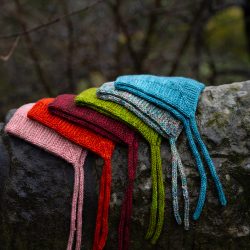Many knitters tell us that they’d love to try Fair Isle colourwork knitting, but they think it’s going to be REALLY HARD. Well I would like to dispel this myth, and show you how simple and fun it really is! Get started by downloading our adorable free pattern, the Clayoquot Hat.

Start by choosing some lovely DK weight yarn. We recommend high-contrast colours so that this pattern really ‘pops’. We have a more in-depth discussion of choosing a palette for colourwork here.

 Download the Clayoquot Hat pattern, choose your size, and get started. This design has a conventional construction: you cast on, work ribbing in the round, then knit a few rounds before starting the pattern.
Download the Clayoquot Hat pattern, choose your size, and get started. This design has a conventional construction: you cast on, work ribbing in the round, then knit a few rounds before starting the pattern.
To work the Fair Isle colourwork pattern, all you do is knit a few stitches in one colour, then switch to another colour, and knit a few stitches in that. The charts show just how many stitches to do in each colour.
If you are confused about how to read a knitting chart, we have a full tutorial here. For this pattern it is very simple – start with chart A, and work round one, reading the squares from right to left (because this is the direction you knit in when the RS of the work is facing you).
So for round 1, you will knit 2 sts with MC (main colour), then knit one stitch with CC1 (contrast colour 1), then knit one stitch with MC. That’s the 4-stitch repeat worked once, then you continue to repeat this pattern, again and again, to the end of the round. When you change colours, you draw the new yarn loosely across the back of the work, creating loose strands called ‘floats’.

Once you’ve finished round 1 of chart A, you simply proceed to work rounds 2, then 3. On round 2, you will be working with 3 colours, not just 2, but that round is only worked twice in the entire knit, so it’s not too much bother.

In terms of technique, you can use one hand to hold the yarn, then drop that yarn when you pick up the other yarn, OR you can hold one yarn in your right hand, and the other in your left to ‘throw’ with the right hand and ‘pick’ with the left. It doesn’t really matter – try both and see with what feels comfortable to you.
Like most techniques in knitting (and everything else I suppose), practice is what you really need to gain competence, but we have put together a few helpful tips below.
LOOSEN UP… this is supposed to be relaxing, right?!
One of the rookie mistakes when knitting fair isle for the first few times is to pull the yarn floats (the strands between the stitches knit in a given colour) tightly across the back of the work, which can compress the gauge of the fair-isle section relative to your stockinette stitch gauge.

There are a few ways to avoid this. If you know that when you knit fair-isle, you always have a tighter gauge than in stockinette, you can adjust for this by using larger needles (1-2 sizes up) for the stranded portion of the work. This will help to avoid a ‘squeezed’ section of fair isle that doesn’t match the rest of the gauge.
Another method, which I personally use, is to knit with the work inside out. This forces the yarn to be drawn along the outside of the cylinder of knitting, rather than along the inside of the cylinder. This means the floats will be longer by default.

DOMINANCE… it’s important in knitting too
In Fair Isle knitting, there is a term called ‘yarn dominance’. Essentially, the yarn that is drawn up from underneath the other yarn creates slightly larger stitches. This yarn, called the dominant one, ‘pops’ more in the colourwork pattern. So it is a beneficial habit to always carry the colour that you want to ‘pop’ underneath the other colour. This also results in the benefit that the backside of the work is very tidy looking and has a beautiful pattern in its own right! Very satisfying, if you’re a little bit OCD like me. Ysolda has a more in-depth discussion of why yarn dominance occurs, and how important it is.
When in doubt, BLOCK IT OUT
Ladies and Gentlemen, knitters all if you’ve gotten this far down the page, let me tell you how much I love blocking! When you are soaking a multi-colour project like the Clayoquot toque, add a little white vinegar to the soaking water, and don’t soak it for too long. This will help to prevent vivid colours from bleeding one into the other.




With this smooth, even yarn, and my relaxed even gauge, you can’t see so much of a difference between the pre-blocking and post-blocking fabrics. But with a ‘woolier’ wool and wonkier tension, you’ll find there is even more benefit to blocking.

I LOVE FAIR ISLE… what shall I knit next?
So once you’ve knit a Clayoquot toque for you (and maybe one for everybody else you know too), what will you knit next? We’ve got a number of cool colourwork projects for you:
Share the Knit Knowledge
Do you have friends who might like to try this free pattern, or benefit from these tips? Share this post, or let them know about all the great free patterns from The Simple Collection. And join in the conversation on Facebook, Instagram, Twitter, Pinterest and Ravelry!














September 19, 2021 @ 8:48 pm
Hi! I.m trying the Banff Mitts as my first stranded yarn pattern. Since there are only a small number of stitches, I am using DPNs and notice that the stranded yarn has to stretch
between needles. It is harder to know if I am making the leap too tight. Do you have tips for using DPNs in this situation? Jane
September 20, 2021 @ 1:51 am
Hi – try knitting the mittens inside out – like we’ve mentioned in this post: https://blog.tincanknits.com/2015/05/26/how-to-knit-fair-isle/
July 22, 2021 @ 12:04 am
I’m new to colour work and have found your tutorials a wonderful source of help. Thank you for the time and effort you put into making them so user friendly.
The one area I’m struggling and have tried numerous different ways-is joining in a new colour at the BOR -my ‘join area’ always seems unsightly and untidy especially if I’m changing colours every round and even after blocking there is a slight improvement but one can see that the yarn is not seamlessly joined. Please could you advise me on the best method to join a new colour. Thanks so much
Sharon
July 27, 2021 @ 9:24 am
Hi Sharon – It is particularly difficult to hide that join when you change colours more frequently. I recommend making sure you are weaving your ends in the opposite direction that they are knit in (it will be one way when you start with a colour and the opposite when you finish with a colour)
May 12, 2020 @ 3:01 am
Hi I just bought the Dog Star pattern, knitting size 4-6 years. For increase round pg 2..k1 m1 knit to 1 stitch from end m1. Knit 5 rounds, not sure when to increase, is it every row on those 5 rounds? Thank you
May 12, 2020 @ 2:52 pm
Hi Marianne – No, you are just knitting 5 rounds, the next instruction tells you how many times to repeat the increase round followed by 5 knit rounds.
September 17, 2019 @ 8:25 am
any tips for yarn tangling while knitting fair isle? i feel as if i spend more time untangling my skeins than i do actually knitting.
September 18, 2019 @ 11:06 am
Hi – I use 1 hand for each colour so they never tangle, I recommend giving it a try. Holding yarn in the opposite hand feels awkward at first but you get used to it, promise!
August 13, 2019 @ 12:01 pm
Would you share tips for avoiding the jog in fair isle when knitting in the round? I think it would be very helpful.
August 15, 2019 @ 9:48 am
Hi Sharon – to be honest, I don’t know of any great ways to avoid the jog. If you’re working a pattern that has ‘whitespace’ (ie non-patterned sections between motifs), you can place the BOR at that part of the pattern. But many patterns you simply have to accept the jog.
August 3, 2019 @ 10:34 am
This tutorial was very helpful…thank you. I love how all your stitches look so even. I’m knitting my first fair isle pattern…a Christmas stocking for my daughter. Do you pick up new color under or over the previous color? I knit only English style so I won’t be using the two hand method.
August 8, 2019 @ 4:23 am
We pick up the contrast colour (the one we want to be ‘dominant’) from underneath the other colour.
May 14, 2019 @ 11:54 pm
I’m knitting the North Shore sweater. I just finished the wave pattern and the jog at the end of the round is really unsightly! I also realize that the trees at the junction will be uneven. What can I do?
May 15, 2019 @ 9:26 am
Hi Sandy – knitting in the round will always produce a jog. I find that it looks quite a bit better once I weave in my ends (weave them in the opposite direction from where they are first/last used), and when I block it I squeeze that part into the best shape possible. The jog will be at the back shoulder so it’s not in a very conspicuous place. Our sweater has a jog too, it’s inevitable
June 22, 2019 @ 11:05 pm
Hi Sandy–Perhaps you might find a solution here: https://www.youtube.com/watch?time_continue=11&v=Eo7NOQ6PpsY
January 23, 2019 @ 9:54 pm
The link to the Color dominance explanation is 404. The new link is here: https://ysolda.com/blogs/journal/colour-dominance
January 25, 2019 @ 11:25 am
Thanks! Just updated the link.
September 22, 2018 @ 11:20 am
What a awesome first time fair isle pattern and it’s all because of how well the pattern is written. I’ve been knitting for about 6 months and I completed a small adult hat with just a few mistakes, and that says a lot. I’m starting a baby toque next. Thank you so much!
September 13, 2018 @ 5:56 am
I knitted a stranded scarf in the round. I’m not adding fringe. Do I use the Kitchener stitch before or after I block the scarf? It’s wool.
September 13, 2018 @ 10:04 am
Hi Peg – this is a bit of a controversial answer (I think some knitters would do it the other way), but I would kitchener first and block second.
November 20, 2017 @ 5:20 pm
I found the tips here to be really helpful, especially the one where you knit with the work inside out. My floats are much looser than before. Thanks for the tutorial.
August 22, 2017 @ 10:34 am
I am knitting fun fair isle jacket size 8
It was really easy until I got to the left front – shape neck.
I’m not understanding pattern as it works with 17 sts and I have 20 sts. What do I do.with the extra 3 sts?
Can someone help me?
June 15, 2017 @ 10:39 am
Just a little FYI: your example is stranded color work, but not technically fair isle. Fair isle only uses two colors per row.
September 23, 2017 @ 1:50 pm
I don’t see any row where she has more than two colors….
October 30, 2017 @ 8:16 am
I agree with Nia. This confusion in terms is somewhat annoying, as there are lots of stranded colourwork variations; not all are (Scottish) Fair Isle. Have a look at: Norwegian, Latvian, (Danish) Faroe Islands, and (Canadian) Cowichan.
In the designer’s instructions above, she indicates in Round 2 of Chart A “you will be working with 3 colours, not just 2.” This is the round with the dark grey ‘bat wings’ & aqua ‘eyes’. See the chart and photo above. It’s lovely stranded colourwork, but not technically Fair Isle.
June 10, 2017 @ 9:06 pm
I just finished knitting a hat for toddler and it turned out beautifully and the instructions were simple and easy to read – thank you great pattern for beginners and a nice project for a baby girl
April 23, 2017 @ 10:09 am
For a first time project I think three colours in the same pattern is challenging. Sticking to two colours allows the knitter have one colour on each hand. I like the patterns.
December 14, 2016 @ 9:33 pm
Your work is beautiful and I appreciate your advise. How many colors can you carry at a time? I’m working on a hat in the round and will have 4 colors (cars and trucks for a boy) on most rounds. Thank you. Debbie
December 15, 2016 @ 11:18 am
Hi Debbie – I suppose the possibilities are endless. Usually fair isle patterns have only 2 at a time, I have occasionally used 3, but I can see how you would need so many colours for cars.
November 27, 2016 @ 6:24 pm
Help! I can’t find 22 stitches x 28 rows gauge yarn! What do I do?
November 28, 2016 @ 1:50 pm
Well, the gauge on the ball band isn’t necessarily the gauge YOU will get. When in doubt the stitch gauge is usually more important than the row gauge
August 9, 2016 @ 2:34 am
How do you combat the fact that the start of the round is a row below the end of the round? The common technique of picking up the stitch below doesn’t necessarily work with all fair isle patterns
August 9, 2016 @ 4:21 pm
Hi – I don’t really combat it, there is usually a jog. I try to keep the beginning of round in the least conspicuous spot and with a block it usually ‘lines’ up a bit better.
February 19, 2017 @ 1:50 am
Would a slip stitch work? Just read that in a book and it looked nicer to me as the pick up below version.
November 11, 2017 @ 7:52 am
Google instructions for “joggless knitting”. These jogs appear when knitting in the round. There are lots of videos to help.
January 27, 2016 @ 7:16 am
Nice blog post. I’ve never tried knitting with the wrong side out—but I’ll try that. Thanks for all the tips. :)
May 29, 2015 @ 5:42 am
Also, tried to print the pattern “Harvest”. Just get first page or two. Seems that the patterns I paid for print, but the free ones don’t.
Sent from my iPad
>
May 28, 2015 @ 4:54 pm
I have just purchased the ebook. Found patterns on Ravelry, downloaded and printed them. Tried to print pattern for the toque yesterday and today, but it only prints part of the first page and nothing else. Is there a problem? Paulette Arnst
Sent from my iPad
>
May 29, 2015 @ 12:13 pm
Hi Paula – I just downloaded and printed the Clayoquot Toque and it worked for me…
May 27, 2015 @ 4:10 pm
Thanks for the great tutorial! I did just that when I blocked my last hat as per advice from Alexa, and they didn’t grow 3 sizes! You ladies are awesome!!😀
May 27, 2015 @ 12:46 pm
I love that idea in particular about working stranded knitting inside out if you’re having trouble keeping the floats loose- great tip!
May 27, 2015 @ 5:11 am
What a wonderful tip,I started knitting in October of last year,I haven’t put my needles down only to work, eat and sleep.I am getting pretty good,lots of trial and error,but Its okay.I really would love to get something started in fair isle .Thank you for the help.
May 26, 2015 @ 10:06 pm
Thanks for all the tips. I’m really enjoying fairisle knitting – you are right about practising with tension!
May 26, 2015 @ 7:15 pm
Seeing your color choice made me think of some yarn leftover from a project with three colours, I might have enough to try this hat. Thanks for the pattern, I have never done Fair Isle before and a hat is really a perfect project to try it.
May 26, 2015 @ 3:32 pm
I’m getting braver….just a little tiny bit….and these patterns are so beautiful, I’m going to give it a try…
May 26, 2015 @ 11:06 am
Wow thanks for the tips…I’ve only tried fairisle once and found my stitches got really uneven. Maybe I’ll try again over winter
H.